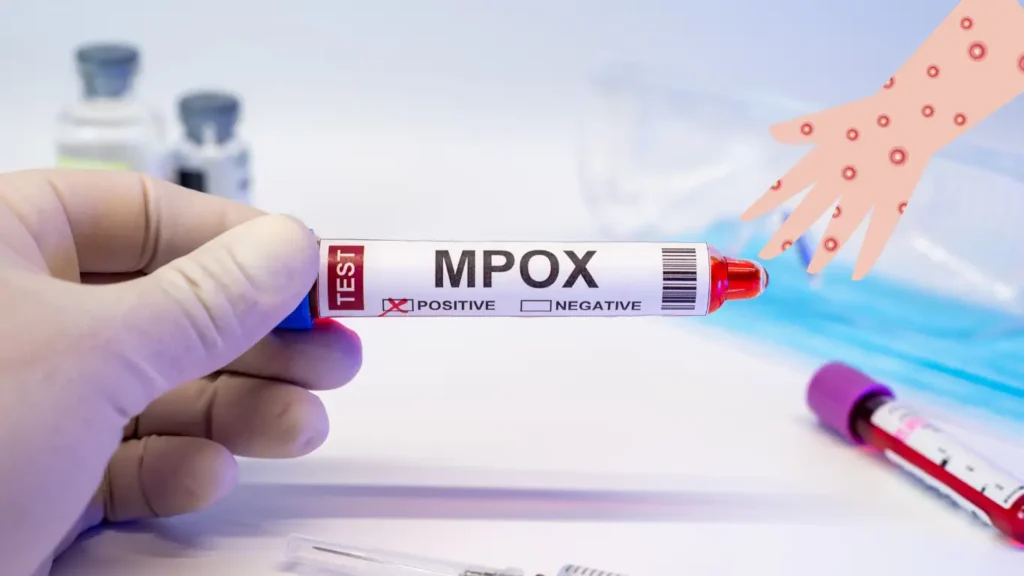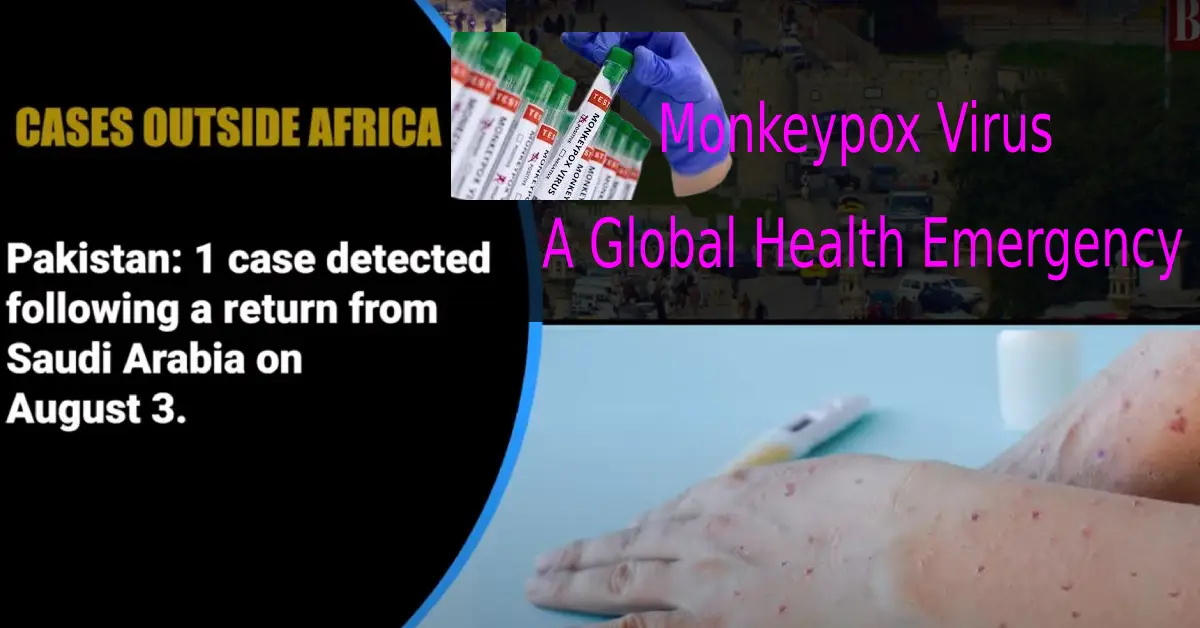Monkeypox Virus:
Contents
The World Health Organization (WHO) has officially declared monkeypox a public health emergency of international concern. This decision comes in the wake of a severe outbreak that has claimed the lives of at least 450 people in the Democratic Republic of the Congo and has spread to neighboring countries such as Burundi, Kenya, Rwanda, and Uganda. The gravity of the situation has prompted global attention, as the virus continues to make its way across borders, raising alarm and concern worldwide.
What is Monkeypox (MPox)?
Monkeypox (mpox) is caused by the monkeypox virus, which belongs to the same family as the smallpox virus—Orthopoxvirus—but is not related to chickenpox. The disease was first identified in 1958 during two separate outbreaks of a pox-like illness in colonies of monkeys kept for research. Despite its name, the true source of the monkeypox virus remains unknown. The first human case was documented in 1970 in the Democratic Republic of Congo, marking the beginning of its recognition as a significant zoonotic disease.
Monkeypox: Key Points
- Cause: Monkeypox is caused by the monkeypox virus, a member of the Orthopoxvirus family.
- Relationship to Smallpox: While in the same family as smallpox, monkeypox is not related to chickenpox.
- Discovery: The disease was first identified in 1958 in monkey colonies.
- True Source: Despite its name, the actual origin of the monkeypox virus remains uncertain.
- First Human Case: The first human case was recorded in 1970 in the Democratic Republic of Congo.
- Zoonotic Disease: Monkeypox is a zoonotic disease, meaning it can be transmitted between animals and humans.
Symptoms of Monkeypox (MPOX)
The symptoms of monkeypox are varied but typically include:
- Rash: The hallmark of monkeypox is a rash that progresses through several stages, starting as macules (flat, discolored areas), moving to papules (raised bumps), then vesicles (small fluid-filled blisters), followed by pustules, and finally scabs before healing. Unlike conventional monkeypox infections that mainly affect the chest, hands, and feet, recent outbreaks have shown a concentration of lesions on the genitals.
- Fever: Often one of the first signs, fever can be high and persistent.
- Sore Throat, Headache, and Muscle Aches: These flu-like symptoms are common early indicators.
- Back Pain and Low Energy: General malaise and discomfort can make the disease particularly debilitating.
- Swollen Lymph Nodes: This is a distinctive feature of monkeypox that helps differentiate it from similar-looking diseases like chickenpox or smallpox.
These symptoms usually appear 1 to 21 days after exposure, making early detection and isolation critical in controlling the spread of the virus.
Monkeypox Virus Outbreak
As of September 6, 2024, the global monkeypox outbreak continues, with significant developments in recent weeks.

Vaccine Distribution: The Democratic Republic of Congo (DRC) has received its first shipment of mpox vaccines, a crucial step in combating the outbreak that has affected the country.
Key Points:
- Vaccine Delivery: The European Union donated vaccines to the Democratic Republic of Congo (DRC) to help combat the monkeypox outbreak.
- Vaccine Arrival: The vaccines arrived in Kinshasa, the capital of the DRC.
- Vaccine Effectiveness: The Health Minister stated that the vaccine has proven effective in the United States.
- Targeted Vaccination: The vaccines will be distributed to adults in provinces heavily affected by monkeypox, such as Equateur and South Kivu.
- Vaccine Source: The vaccines are produced by Bavarian Nordic, a Danish pharmaceutical company.
- Age Restriction: The vaccine is currently only approved for adults. Trials for children are ongoing.
Transmission and Spread
The monkeypox virus spreads through direct contact with the blood, bodily fluids, or cutaneous or mucosal lesions of infected animals or humans. In some instances, it can also spread through contact with contaminated materials, such as bedding or clothing.
There are two distinct strains of the monkeypox virus:
- Central African (Congo Basin) Type: Known for causing more severe illness with higher fatality rates, some outbreaks have seen up to 10% of infected individuals succumb to the disease.
- West African Type: This strain is less severe and was responsible for the global outbreak in 2022. Despite its widespread reach, the survival rate for this strain is over 99.9%.
In July 2022, the milder West African strain spread to nearly 100 countries, infecting more than 87,000 people and resulting in 140 deaths, according to WHO reports. Recent cases have been detected in Pakistan and Sweden, following international travel, highlighting the virus’s ability to cross continents.
Global Response and Future Outlook
The global response to monkeypox has been swift, but challenges remain. The WHO’s declaration underscores the need for heightened vigilance, rapid diagnosis, and effective containment strategies to prevent further spread.
The outbreak serves as a stark reminder of the interconnectedness of global health and the importance of international cooperation in combating infectious diseases. As the world grapples with this latest public health emergency, the lessons learned from past epidemics like smallpox and COVID-19 will be crucial in navigating this new challenge.
The fight against monkeypox is far from over, but with continued global efforts, the tide can be turned in favor of public health and safety.
- Swift Action: The global response to monkeypox has been prompt, but challenges persist.
- WHO Declaration: The WHO’s declaration highlights the need for increased vigilance, rapid diagnosis, and effective containment measures.
- Interconnectedness: The outbreak underscores the interconnectedness of global health and the importance of international cooperation.
- Lessons from Past: Experiences from past epidemics like smallpox and COVID-19 will be crucial in addressing this new challenge.
- Ongoing Battle: The fight against monkeypox is not yet over, but continued global efforts can help mitigate its spread and protect public health.
WHO Declares Mpox Outbreak a Public Health Emergency of International Concern
WHO Director-General Dr. Tedros Adhanom Ghebreyesus has declared the mpox outbreak in the Democratic Republic of the Congo (DRC) and other African countries a Public Health Emergency of International Concern (PHEIC). This decision follows a recommendation from the International Health Regulations (IHR) Emergency Committee, which expressed concern over the rapid spread of a new mpox clade in eastern DRC and neighboring countries.
Mpox, caused by an orthopox virus, has been endemic in central and west Africa since 1970, with a notable increase in cases in recent years. The current upsurge, particularly of clade 1b, which spreads through sexual networks, has led to over 15,600 cases and 537 deaths this year alone. The virus has now reached countries like Burundi, Kenya, Rwanda, and Uganda, which had not previously reported mpox cases.
WHO is responding with enhanced international efforts, including vaccine distribution, surveillance, and funding. An initial $15 million is required to support the response, with $1.45 million already released from the WHO Contingency Fund for Emergencies. The declaration underscores the need for coordinated global action to prevent further spread and save lives.
- PHEIC Declaration: The WHO Director-General has declared the mpox outbreak in the Democratic Republic of the Congo and other African countries as a public health emergency of international concern (PHEIC).
- Expert Advice: The decision was based on the advice of an IHR Emergency Committee.
- Potential for Spread: The Committee believes the outbreak poses a risk of further spread within Africa and beyond.
- Global Response: A coordinated international response is needed to stop the outbreaks and save lives.
- Regional Efforts: WHO’s Regional Director for Africa emphasized ongoing efforts to curb the outbreak.
- Previous PHEIC: This is the second PHEIC declaration for mpox in two years.
- Rising Cases: The number of mpox cases in the DRC has been increasing steadily.
- New Virus Strain: The emergence and rapid spread of a new virus strain, clade 1b, is particularly concerning.
- Neighboring Countries Affected: Over 100 cases of clade 1b have been reported in four neighboring countries.
- Multiple Outbreaks: Different clades of mpox have occurred in various countries with varying transmission modes.
- Vaccine Availability: WHO recommends two vaccines for mpox, and is working to accelerate access for lower-income countries.
- Funding Needs: WHO anticipates an initial funding requirement of US$15 million to support response activities.
FAQ’s,
1. What is Monkeypox?
Monkeypox is a viral zoonotic disease caused by the monkeypox virus, related to smallpox but not chickenpox. It was first identified in 1958 and in humans in 1970 in the DRC.
2. How is Monkeypox transmitted?
It spreads through direct contact with infected bodily fluids, skin lesions, or contaminated materials, and less commonly through respiratory droplets.
3. What are the symptoms?
Symptoms include a characteristic rash, fever, swollen lymph nodes, and flu-like symptoms.
4. Why is it a global health emergency?
Due to its rapid spread in Africa and beyond, the WHO declared it a public health emergency, emphasizing the need for global vigilance and coordinated efforts to contain the outbreak.


1 thought on “Monkeypox Virus: A Global Health Emergency”